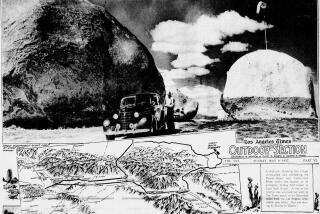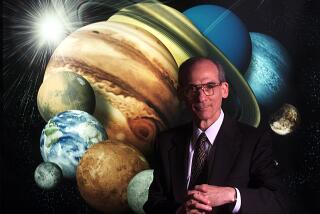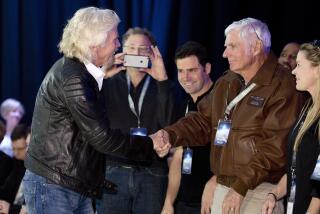Lifeâs a Blur to Fast-Flying Voyager Crew
SAN BERNARDINO â Dick Rutan and Jeana Yeager were tired. There were circles under their eyes as they sat next to each other, answering questions.
Since December, when they made their record-breaking nonstop around-the-world flight without refueling in their homemade airplane, Voyager, they have done so hundreds of times.
This time, they were sitting on a desk at California State University, San Bernardino, before one of the speaking engagements for which they are paid between $10,000 and $20,000 each appearance.
Same Old Questions
Since Voyager touched down at Edwards Air Force Base on Dec. 23, Rutan and Yeager have been crisscrossing the United States--with side trips to Europe and Japan--for paid lectures at places like Cal State and unpaid appearances on behalf of Voyager sponsors. And they have learned that part of celebrity means being asked, over and over again, the same questions.
âWhatâs next?â It came from a student this time.
Rutan dislikes that one. The tall, 48-year-old Rutan usually says he has âno comment,â or mentions the book he and the petite, blue-eyed Yeager, 34, are writing.
But now, perhaps because he was so tired, the dark-haired former Air Force fighter pilot threw his right arm in a brief upward gesture and said: âThatâs the problem with this thing. What are you going to do next?â
He paused. The two aviators had spent years breaking lesser records before this, he said: âThen you end up in the World Series or the Olympics and you stand there and you own the Gold Medal. What do you do then?â
He paused again, gave a short laugh and said, âIâm going to savor the moment.â
There have been many moments--the Citizenâs Medal from President Reagan, an invitation to a White House dinner for French Premier Jacques Chirac, whirlwind tours of Paris, London and Tokyo.
Yet, while a lot has changed, the two pilots say, much has not.
Their simpler life style in Mojave has given way to constant travel, first-class accommodations, and instant recognition from strangers. But they are still chasing the dollar, as they did before the flight in quest of financial support for the Voyager.
Rutan claims they are not getting rich now, but are still trying to pay off âabout $300,000â in debts. He refuses to disclose how much the Voyager project actually cost or how much has been paid back so far through current activities.
By the end of the year, âweâll probably be even with the world,â he told a health sciences class at Cal State San Bernardino, before a formal lecture to about 700 students and local residents.
Rights for Movie
Before the flight, Rutan said, he and Yeager delivered lectures to much smaller groups and then âweâd run around the back before people could leave, and try to sell them a poster.â
Now, according to Carlton Sedgeley, their New York speaking agent, the two make $10,000 for appearances at a college or university, $15,000 for a national association or corporation, and $20,000 for appearances outside the country. And when the lectures are over, people line up for autographs.
The movie rights to their story have been bought by Heritage Entertainment in West Los Angeles, president Skip Steloff said, for a âhigh six figureâ price.
In San Bernardino, the two pilots wore matching maroon flight suits, with the words âVoyagerâ and their names angled in black and white across their chests. Each had pens stuck in holders sewn onto the outer sleeves.
They wear the suits at most appearances, alternating among five different colors, including the silver one worn in a Master Card commercial now running on television. On the actual flight, they had worn simple jogging suits from K mart.
The pair maintains such a grueling schedule that the various cities and towns they visit, Yeager said, âget like a blur.â In the week before their visit to San Bernardino, the two had done paid speaking engagements for the Boy Scouts in Columbus, Ohio, students at Oklahoma State University, and a womenâs conference in Anaheim.
They had also, for no fee, done what Yeager calls âgive-back daysâ to Voyager sponsors, and there are actually more of these than paid appearances. Before the flight, âWe bartered a lot of ourselves for the materials,â she said.
So that same week, they had also made publicity appearances in Olathe, Kan., for King Radio, which designed their navigational equipment; in Piqua, Ohio, for Hartzell Corp., the makers of their propellers; in Denver, Colo., for Beech Aircraft Corp., which lent them a private airplane; and in Los Angeles for Lawry Foods, which donated money to the project.
In a typical example of the way they spend their time, one day Rutan flew the borrowed airplane from Denver--after opening a new Beech facility--to Mojave. Then he took a commercial flight to Kansas City, Mo., to meet Yeager, who had just spent Easter Sunday with strangers.
The next morning they received an award from a philanthropic business group in Kansas City, then flew to Los Angeles International Airport, where they were helicoptered to a womenâs conference in Anaheim for an evening banquet speech.
Travel delays had made them more than two hours late--too late to eat dinner. So they just plunged into their presentation. That typically includes more than 100 slides and films of the Voyager, lasting about two hours.
Not Much Extra Time
In all, during the first four months of this year, Rutan and Yeager have spent only about 16 days, spread out here and there, in Mojave, where they live and the Voyager plane is still on display at Mojave Airportâs hangar 77.
âWeâre almost averaging 1.8 or 1.9 (appearances) per day,â Rutan said. âThereâs no time to do anything. Iâm getting concerned about that.â
According to Sedgeley, they have 60 speaking engagements scheduled through March, 1988.
Even New York writer Phil Patton, the collaborator on their book to be published by Alfred A. Knopf this fall, must struggle for their time. He sends manuscript pages to them, Rutan said, âand we send our comments back on tape.â
But the pace of their lives is not so very different from the hectic period before the Voyager flight, the pilots said.
Before, âIâd get up and start work at 8 a.m. and it would be 2 a.m. or 3 a.m. before Iâd go home. . . . We never knew what holidays were,â Yeager said. âWeâre still working hard. The hours are still unreal.â
And they still are together, though their relationship is no longer a romantic one; that apparently ended before the flight. The couple, who met at an air show in 1978, donât discuss the subject at any length. But it is one of âthe questionsâ frequently asked.
In Stillwater, Okla., the couple answered written queries from students, their families and friends at a banquet arranged by Oklahoma State Universityâs Flying Aggies. The student flying club had done car washes and sold airplane rides to raise the $10,000 to bring them to campus.
âAre there any wedding bells in the future?â someone asked.
âNo,â Rutan replied tonelessly. âJeana and I are business partners. Weâre friends and traveling companions and thatâs all.â Yeager just smiled.
Rutan does most of the talking and is the center of attention, always. Yeager--no relation to famed pilot Chuck Yeager--stays very much in the background, adding a few remarks here and there, and otherwise maintaining a pleasant smile. He refers to her in the talks as a âbrave little ladyâ or a âbrave little girl.â
âWhat were you doing before the project started?â an Oklahoma reporter asked, at a press conference in Stillwater.
âJeana was ridinâ horses,â Rutan said in the folksy, warm manner that seems to endear him to audiences. âAnd I was flyinâ airplanes.â
âNo, I wasnât,â Yeager said in a small voice. Rutan stared at her blankly.
âWhat were you doing?â the reporter asked her. Yeager said she worked as a mechanical draftsman for a commercial rocket program. But her words were inaudible, so reporters asked her to repeat them.
âShe was working in a private rocket program,â Rutan said.
But this public impression can be misleading. Although she seems shy in public, members of the Voyager team and other volunteers in Mojave have described Yeager as a tough and determined woman--possibly the catalyst behind the success of Voyager.
âIâve always been the kind of person, if I said Iâd do something, I do it,â she said recently.
Rutanâs speech covers the basic facts of their six-year quest, including how they built the Voyager without government help, but through private funds raised grass-roots style. He details the historic journey, the mechanical failures, the bad weather, and the fear that they did not have enough fuel to complete the 25,000-mile journey.
The talk also includes many details, such as that they averaged only two hours of sleep a night and that they ate their meals cold, without bothering to heat up the bland food--âto get it over with,â Rutan said.
He also addresses another often-asked question, about elimination during their nine-day flight.
Urine was carried through a plastic funnel and a tube stuck out of the plane through the fuselage, he explained, adding with a laugh: âWe only forgot to extend it once.â
Sometimes the force of his words is surprising. His favorite moment of the trip, he said, was âtouching down on the dry lake, an unbelieveable sense of relief that the nightmare was finally over.â
A self-conscious conceit comes through as well. He always tells, for example, how his legs seemed to give out when he started to climb out of the cockpit after the Voyager had landed. That was why, he would explain, he sat for a long time, exercising his feet and legs before getting down--so that he could walk without assistance before the hundreds of television crew members and photographers gathered.
Would Not Be Carried
âThere was no way anybody was going to carry me off that airplane. Iâd have died first,â he said.
âJeana, did you have that?â he asked her during the San Bernardino appearance.
âI was walking before you were,â she said with a smile.
At rare intervals during the two-hour lectures, Yeager briefly speaks and often addresses another common question: Why she only piloted the plane for a fraction of the flight. The clear-colored canopy over the pilotâs seat was âabove my miserable level,â she said. Rutan could see out, but she could not. âWe were in so much (bad) weather,â she added, âI couldnât see out to fly the airplane and to avoid the clouds.â
Another frequently asked question is, âWhere is Voyager?â
The plane is scheduled to leave Mojave May 8. After being transported in a larger plane to some air shows, it will go on display at the Smithsonianâs Air and Space Museum in Washington.
In San Bernardino, Rutan used that question to return to a favorite anecdote.
âThereâs a yellow streak on the right side of the fuselage,â he said, caused by urine. âThe Smithsonian, I asked them if they wanted it cleaned up. They said no, they wanted it exactly the way it landed.â
More to Read
Sign up for The Wild
Weâll help you find the best places to hike, bike and run, as well as the perfect silent spots for meditation and yoga.
You may occasionally receive promotional content from the Los Angeles Times.






